Yom Kippur War. How the Arabs Almost Defeated Israel
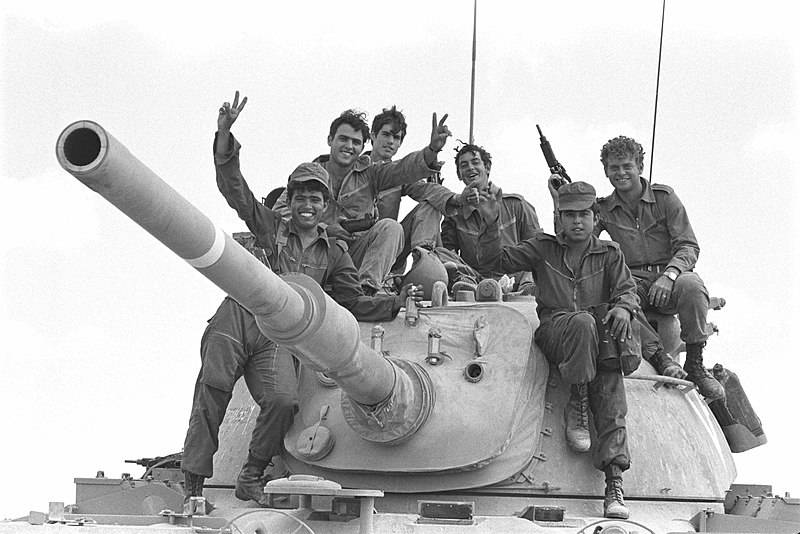
Doomsday War
In Israeli historiography it is called the Yom Kippur War, in Arabic it is called the October War. At 3:50 a.m. on October 6, 1973, on the day of the Yom Kippur fast (the holiest day of the year for Jews, when life in the country comes to a standstill), a telephone call woke up the head of the Israeli government, Golda Meir.
The call was from her military secretary, Israel Lior, who reported an urgent notification from the head of the Mossad foreign intelligence service, Zvi Zamir, who had traveled to London to meet with a high-ranking source. Later it became known that it was Ashraf Marwan, the son-in-law of the then deceased Egyptian President Gamal Abdel Nasser.
Zvi Zamir reported that Egypt and Syria are planning to jointly attack Israel. Soon the Prime Minister received a full report from the head of the Mossad. It was reported that the enemy would strike in the early evening of October 6. The military plans of Syria and Egypt were described in some detail. The Israeli army begins mobilization. The enemy struck a little earlier - at 2 o'clock in the afternoon.
The war came as a surprise to the Jewish leadership. Israeli intelligence services knew about the redeployment of the Arab armed forces and more than once received warnings about a possible attack, but they were mistaken in their assessment of what was happening. On the one hand, this was caused by competition between the Mossad and military intelligence. On the other hand, with the position of the political leadership.
After the war, under public pressure, a commission was created to investigate the miscalculations of the leadership on the eve and at the beginning of the war. It was headed by former Chairman of the Supreme Court Shimon Agranat. The commission found the chief of the General Staff David Elazar, the head of military intelligence Eli Zeira and the commander of the southern military district Shmuel Gonen (his first name is Gorodish) to be the main culprits.
However, later, after studying memoirs, interviews and declassified documents, researchers came to the conclusion that Agranat’s commission judged the events biasedly. She saved the reputation of Prime Minister Golda Meir, Defense Minister Moshe Dayan and members of their cabinet, making professional military men scapegoats.
In particular, Golda Meir met with King Hussein of Jordan a week before the war, who warned her that Syrian troops were ready to attack. On October 3, the prime minister held a meeting with the Minister of Defense, high military command and Foreign Minister Yigal Alon. It was concluded that there was no immediate threat of war with the Arabs.
The fact is that at that moment the senior military-political leadership of Israel was convinced of the invincibility of the Israeli army. The Israeli military always beat the Arabs. After the Six Day (June) War of 1967, Israel was in euphoria. It was believed that the enemy was defeated for a long time. Then, as a result of a preventive strike, the Jews quadrupled the territory of their state. The West Bank was captured (historical Judea and Samaria), Gaza Strip, Sinai Peninsula and Golan Heights. The country was on a socio-economic boom.
The ruling Labor party was preparing for the elections, and its election slogans read:
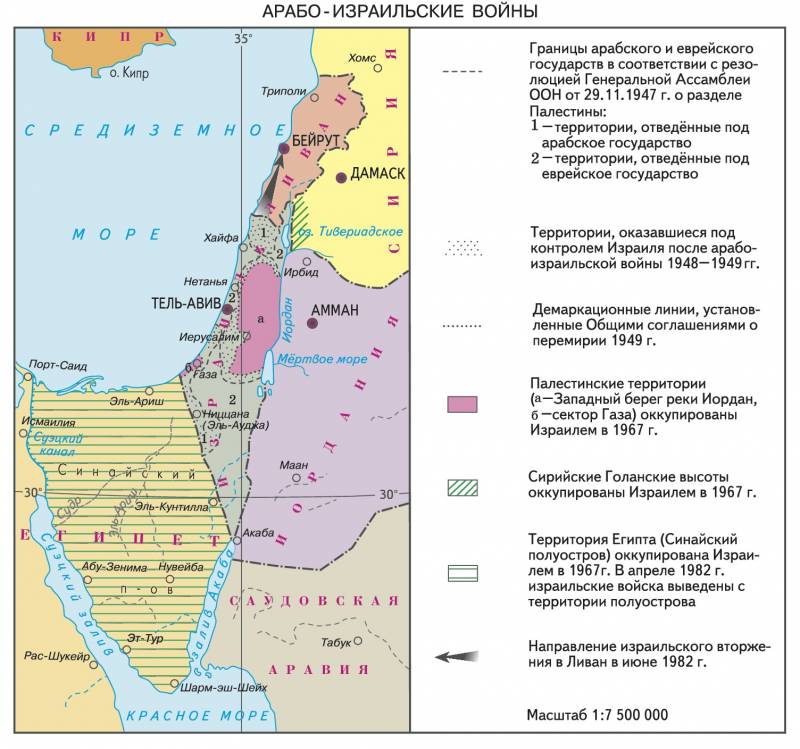
Bet on revenge
Completely different moods reigned in Arab society. The crushing defeat in the Six-Day War caused a crisis in the idea of Arab nationalism and Arab unity. The development of political Islam, including its radical movements, begins. The war brought disappointment and a feeling of disaster. This was especially noticeable in Egypt, which claimed to be the leader of the Arab world.
Anwar Sadat, who became President of Egypt in 1970, tried to revive Egypt's importance in the Arab world and, to do this, intended to take revenge for the humiliating defeat in the Six-Day War. Sadat refused military assistance to the USSR and began rapprochement with the United States. At the same time, Egypt retained the military potential created with the help of Moscow.
The Arabs had a serious military advantage. The total strength of the Egyptian and Syrian armed forces was approximately 750 thousand people. And with the participation of allied troops - over 1,1 million people. Israel deployed 375 thousand soldiers at the beginning of the campaign, and 415 thousand after general mobilization.
The Egyptian Air Force had 550 aircraft, the Syrians had 310, and the Israelis had 480. The Arabs also had tank superiority: 2 thousand new Soviet tanks from the Egyptians plus 1,2 thousand from the Syrians. The Israeli tank forces had 1,7 thousand vehicles, many of which were outdated models. The Arabs had more than double superiority in guns and mortars, and triple superiority at sea.
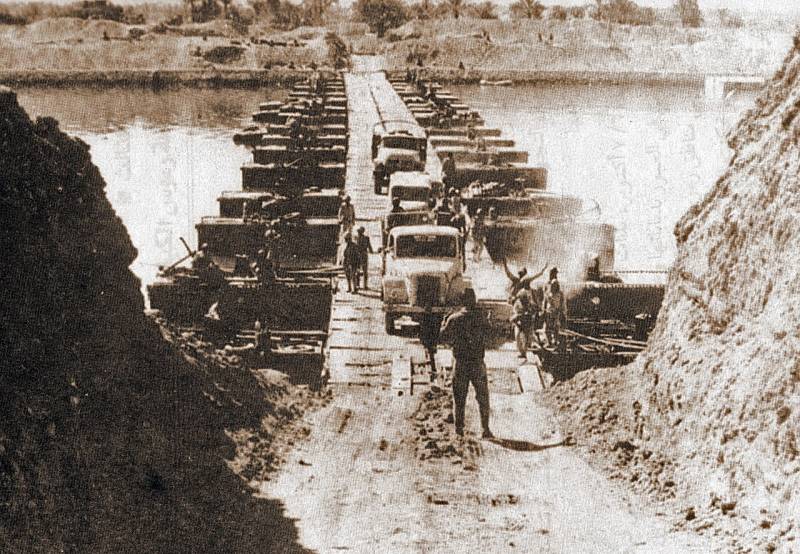
Egyptian troops crossing the Suez Canal
Arab blitzkrieg
The beginning of October 1973 became the most terrible days in the history of Israel. It seemed that the Jewish state was over. Cairo and Damascus prepared the operation well. Israel was beaten from two sides - on the Egyptian and Syrian fronts. Detachments of Iraqis, Jordanians, Libyans, Moroccans and Algerians also entered the war. Pilots from Pakistan fought against Israel.
The Arabs have well learned the lessons of 1967, the developments of Soviet advisers, and studied the experience of the enemy himself. They were perfectly armed with the best military equipment from the USSR in the world at that time. They were able to strike suddenly and seize the initiative.
The Egyptians struck through the Suez Canal, swept away the weak enemy defenses and broke into Sinai. It was a classic operation of the era of industrial states: massive artillery preparation, tank wedges from hundreds of tanks. Soviet Mi-8 helicopters land Egyptian troops behind enemy lines, demoralizing the Jews and disrupting communications. Israel is losing air supremacy: the enemy has powerful air defense. For the first time in battle, Soviet mobile air defense systems of the "Cube" type, anti-aircraft self-propelled guns "Shilka", man-portable missile systems "Strela-2".
The Jews did not have time to preemptively strike Egyptian airfields, and their air force was forced not to seize air supremacy, but to make sorties to save their ground forces, to strike enemy positions and columns. Here the Jewish Air Force ran into heavy fire from Arab air defenses and suffered heavy losses.
At the same time, Israel attacked Syrian troops in the Golan Heights. Heavy fighting began there, the Israelis were being pushed back. The Syrians were able to fire at Israeli territory. The situation was critical. On each front, the enemy had a noticeable advantage in forces and resources over the Jews. It seemed that Egyptian and Syrian troops would crush the Jewish state.
The Israelis are trying to launch a massive attack on Egyptian troops in the Nile Valley, having assembled a strike force of 70 Phantoms. As in 1967, planes enter from the Mediterranean Sea. But now they were faced with strong air defenses built under Russian leadership. Jewish planes intercept the MiG-21. The Israelis lose 18 vehicles, shooting down 4 enemy vehicles.
In attempts to suppress Syrian air defenses and bomb airfields, the Israeli Air Force also suffers heavy losses. Before the start of the war, Israel had 99 F-4s, and about 55 were lost. The United States, in order to make up for these losses, delivered 52 Phantoms to Israel in two batches at the end of October.
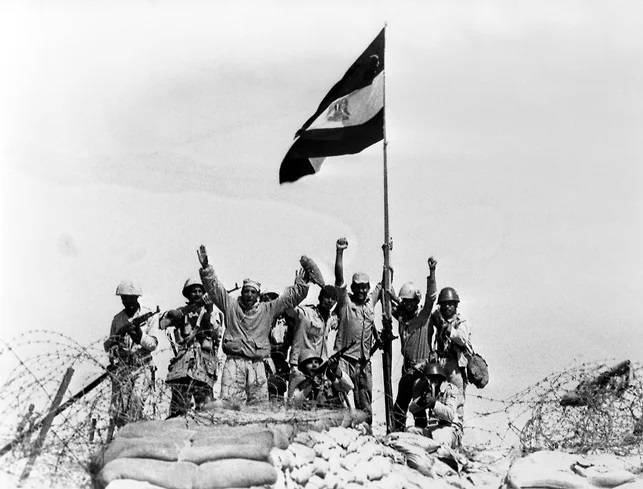
Egyptian soldiers after breaking through the Bar Leva line in the Suez Canal area in the first week of the war
USA saves Israel
Israel was able to attract the United States to its side. Americans are making emergency supplies weapons by air. A powerful Jewish American, US Secretary of State Henry Kissinger, came out on Israel's side. He bluntly told Anwar Sadat: America will not tolerate the defeat of Israel. And if Cairo wants to receive American investment, then there is no need to do anything stupid.
As a result, the Egyptian troops, which had penetrated the Sinai Peninsula with the forces of the 2nd and 3rd armies at 15–20 km, stopped on October 9–13. The Arabs began to gain a foothold in the occupied territories, instead of developing an offensive, not allowing the enemy to come to his senses.
Therefore, the Jews were able to come to their senses, regroup their forces and launch a counteroffensive. The Israelis regained previously lost positions and then struck themselves.
Egypt is losing strategic initiative.
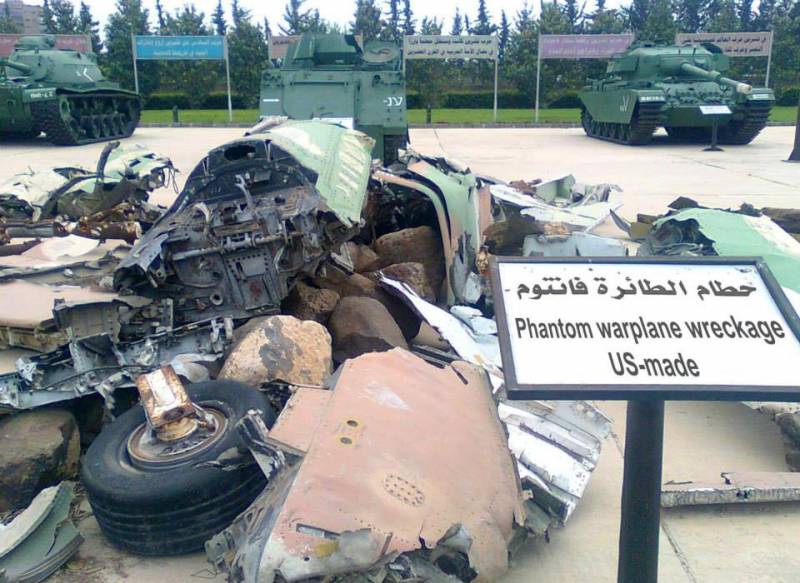
The wreckage of an Israeli Phantom shot down by the Syrians in 1973
Israeli blitzkrieg
On October 15, the Israeli army went on the offensive on the Sinai-Suez front. The main blow was delivered to the 2nd Egyptian Army, which held the left flank. The Israelis reached the Great Bitter Lake, which is located between the northern and southern parts of the Suez Canal. The solid front of the Egyptian troops was torn by this lake. This lake became the key to the victory of the Israeli troops.
On the evening of October 16, several amphibious tanks and amphibious armored personnel carriers crossed the lake and created a bridgehead behind enemy lines. For some reason, the Egyptians slept through the enemy landing. They thought it was impossible. According to them, the Jews had no means of transportation.
The next night, another 30 tanks were transported to the other side, and the bridgehead was expanded. The Israelis then transported another 60 tanks to the east bank. On the night of October 19, the Israelis built two floating bridges across the Great Bitter Lake and transferred new infantry and tanks.
He commanded the strike force (143rd Armored Division) - “Bulldozer”, the desperate brave man Ariel Sharon. He carried out the operation in the best traditions of the German Wehrmacht of 1939–1941. Many battle groups burst into the Egyptian rear, forcing a tank company, reinforced by mobile infantry on armored personnel carriers. Someone was specially dressed in Egyptian military uniform.
Sharon's mobile groups looked for weak points in the rear of the Egyptians, and from the rear they destroyed the positions of air defense systems, artillery, headquarters and rear bases. Panic began among the Arabs. Israeli aviation supported the strike force from the air, the Arab air defense was noticeably weakened by the actions of mobile groups.
The Israelis took a big risk. The crossings could be destroyed by Arab air forces and artillery. Sharon's troops would have been completely surrounded, deprived of the supply of fuel and ammunition. However, a miracle happened again. Egyptian President Sadat ordered a stop to the massive artillery shelling of the crossings that had begun, and the Egyptian special forces brigade aimed at destroying the pontoons received a strict ban from Cairo to carry out this operation.
As a result, the Israelis successfully defeated the enemy's rear and blocked the 3rd Egyptian Army. Soon, 300 Israeli tanks crossed the Suez and prepared to rush to Cairo.
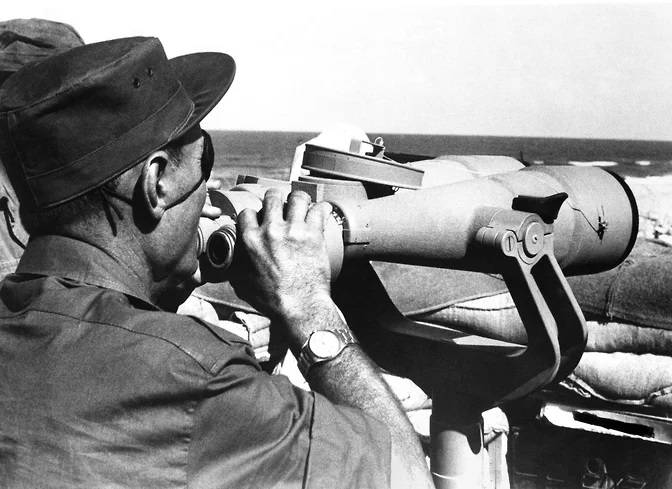
Israeli Defense Minister Moshe Dayan is a hero of the Six Day War and a controversial figure in the Yom Kippur War. In the photo he is at the site of the disengagement of Egyptian and Israeli forces in the Suez Canal area after the ceasefire
Cairo began to play giveaway
Egyptian President Sadat caved in under Kissinger's pressure and did not dare to win. He didn't have enough will to finish off his opponent. He wanted to receive American financial assistance of $2 billion annually to rebuild the country's economy. It is clear that this helped him and other Egyptian dignitaries get rich.
It is worth noting that Moscow, which at that time was intensively arming Egypt and Damascus (on October 9–22, an average of 30 planes with Soviet equipment arrived per day), also insisted on peace. The USSR did not want the defeat of Israel.
At the same time, Washington and Moscow were negotiating the possibility of a ceasefire. Kissinger flew to Moscow. Both sides urged Cairo to stop. At the same time, from the very beginning of hostilities, it was proposed that everyone remain in the territories occupied at the time of the conclusion of the ceasefire agreement. At first, this did not suit Israel at all.
Damascus took the toughest position. Therefore, according to some sources, the Syrians received a warning that if they crossed the Jordan, the Israeli army would launch a nuclear attack on Damascus.
As a result, Sadat caved in and asked for a truce.
On October 22, the UN Security Council adopted resolution No. 338 on a ceasefire and called for the implementation of the resolution of November 22, 1967. Israel continued fighting. Then Moscow exerted military-political pressure on the United States and Israel.
The USSR warned Israel “of the most severe consequences” if it continued aggressive actions against Egypt and Syria. At the same time, Brezhnev sent an urgent telegram to Nixon, in which he assured the American side that if it was passive in resolving the crisis, the USSR would be faced with the need to “urgently consider taking the necessary unilateral steps.”
Moscow is preparing airborne divisions for deployment to the conflict zone. Israeli troops stopped their offensive and the war ended on October 25.
On January 18, 1974, at the 101st kilometer of the Cairo-Suez highway, in the presence of the American delegation, Egyptian representatives signed an agreement with the Israelis on the disengagement of troops. Israel withdrew its troops 32 km from the Suez Canal. On May 31, a similar agreement, but with the mediation of the USSR and the USA, was signed by Israel and Syria. Part of the Golan Heights with Quneitra was returned to Syria on the terms of demilitarization and the deployment of UN troops here.
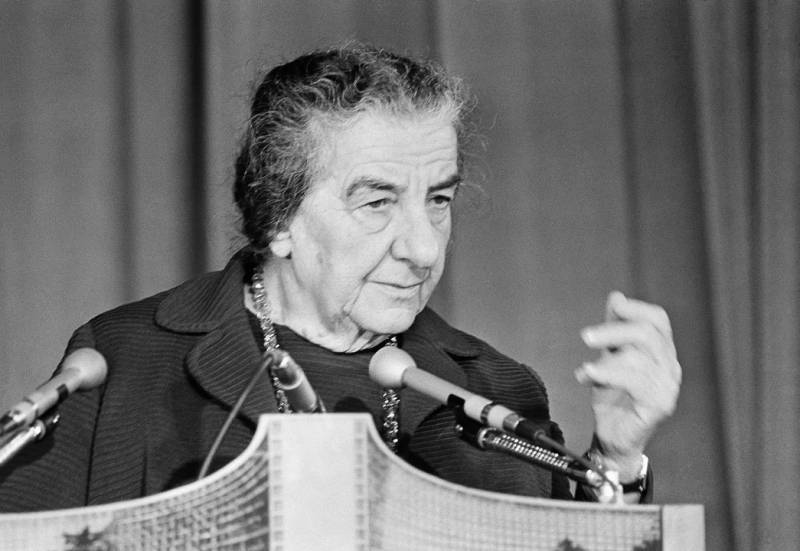
Israeli Prime Minister Golda Meir admitted her responsibility for the fact that the country was not ready for war and resigned
Results
The fighting continued for almost three weeks. During this time, 2,5–3 thousand Israeli soldiers were killed, 7–9 thousand were wounded. Several hundred people were taken prisoner. Data on Arab losses vary greatly - from 8,5–9 to 18 thousand dead, from 19 to more than 50 thousand wounded, 8–9 thousand prisoners.
In September 1978, at the Camp David summit chaired by Jimmy Carter, Sadat and Israeli Prime Minister Menachem Begin agreed on peace, mutual recognition and the return of the Sinai Peninsula to Egypt. The peace treaty was concluded on March 26, 1979.
Israel has pledged to withdraw troops and evacuate Jewish settlements from the Sinai Peninsula, which it occupied in 1967. In 1978, Anwar Sadat and Menachem Begin were awarded the Nobel Peace Prize for signing the peace agreements. Israel's peace talks with Syria ended without results.
Egyptians celebrate October 6th as a day of great victory. Society was on the rise. Again, for a short time, the illusion of unity of the Arab and Islamic worlds arose. Arab countries, in solidarity with Damascus and Cairo, declared that they would not supply oil to the United States and other Western countries that supported Israel. As a result, world oil prices quadrupled. The oil crisis lasted until March 1974.
The illusion of Arab unity quickly collapsed; in 1977, Sadat was the first Arab leader to visit Israel, and two years later he signed a peace agreement with it. Egypt was expelled from the Arab League for ten years. On October 6, 1981, during a parade marking the anniversary of the war, Sadat was assassinated by Islamists.
Israeli society took this war hard. The Yom Kippur War showed that you can lose an entire country in an instant. The Jews were looking for mistakes, experiencing the failure of the military-political leadership. In 1974, amid a wave of protests unprecedented at that time, the government of Golda Meir resigned.
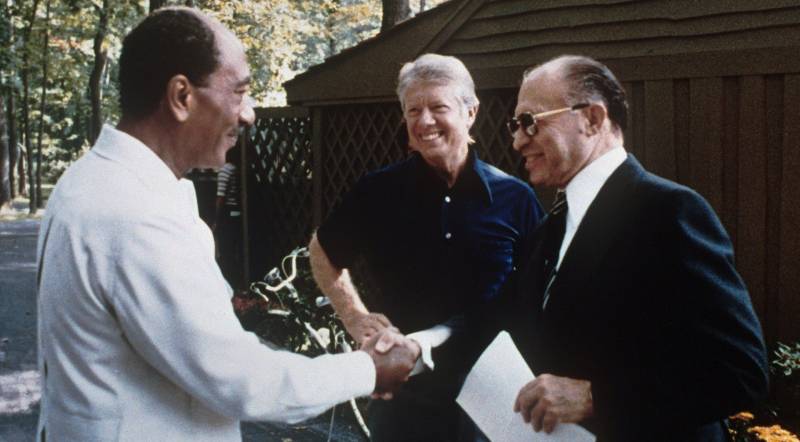
Camp David Agreement. Sadat (left) shakes Begin's hand in Carter's presence. 1978
Information